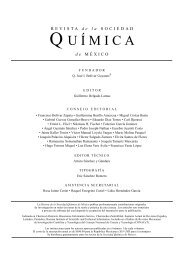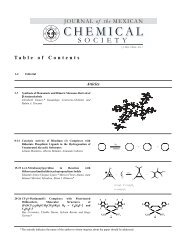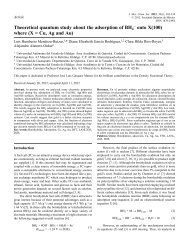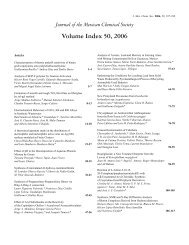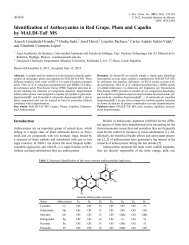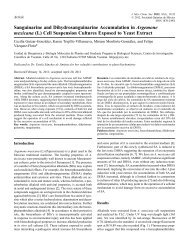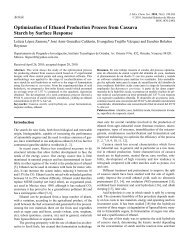SMQ-V047 N-002_ligas_size.pdf - Journal of the Mexican Chemical ...
SMQ-V047 N-002_ligas_size.pdf - Journal of the Mexican Chemical ...
SMQ-V047 N-002_ligas_size.pdf - Journal of the Mexican Chemical ...
You also want an ePaper? Increase the reach of your titles
YUMPU automatically turns print PDFs into web optimized ePapers that Google loves.
Syn<strong>the</strong>sis, Structural, and Theoretical Study <strong>of</strong> New β-Heterosubstituted Captodative Olefins 1-Acetylvinyl Arenecarboxylates 111<br />
Table 4. Comparison <strong>of</strong> X-ray selected bond distances (Å) (estimated standard deviations) <strong>of</strong> <strong>the</strong> crystal structure <strong>of</strong> 10f with those <strong>of</strong> olefins<br />
1a, 3a, and 7b, and with <strong>the</strong> average lenghts <strong>of</strong> bonds <strong>of</strong> <strong>the</strong> enone, enamine, vinyl ester and bromo vinyl systems.<br />
Bond 10f 1a a 3a b 7b b Average Length c<br />
O(4)-C(3) 1.208 (4) 1.215 (5) 1.20 (3) 1.231 (7) 1.222<br />
C(2)-C(3) 1.470 (5) 1.490 (5) 1.40 (3) 1.41 (1) 1.462<br />
C(1)-C(2) 1.320 (4) 1.306 (6) 1.42 (3) 1.366 (9) 1.340<br />
C(1)-Y(5) 1.725 (4) 1.79 (3) 1.32 (1) 1.712 (S); 1.881 (Br);<br />
1.358 (Nsp 2 ); 1.418 (Nsp 3 )<br />
C(2)-O(6) 1.412 (3) 1.398 (4) 1.41 (3) 1.423 (7) 1.353<br />
O(6)-C(7) 1.355 (4) 1.353 (4) 1.38 (2) 1.354 (6) 1.359<br />
C(7)-O(8) 1.195 (4) 1.200 (4) 1.21 (3) 1.188 (6) 1.201<br />
C(7)-C(9) 1.486 (4) 1.488 (5) 1.50 (3) 1.481 (7) 1.481<br />
a Ref. [11]. b Ref. [6]. c Ref. [19]<br />
Table 5. Ab initio HF/6-31G* calculations <strong>of</strong> coefficientes (C i ) <strong>of</strong> <strong>the</strong> frontier molecular orbitals for olefins 1a, 3a, 7a, 7b, 10a, 10f, and 10g,<br />
and diene 5. a HOMO LUMO<br />
Compd b C 1 C 2 C 3 C 4 ∆C i<br />
c C 1 C 2 C 3 C 4 ∆C ι<br />
c<br />
3a –0.2456 –0.2839 0.0095 0.1277 –0.0383 0.3188 –0.2499 –0.2783 0.2759 0.0689<br />
7a –0.1192 –0.3110 –0.0215 0.1414 –0.1918 0.2701 –0.1547 –0.2314 0.2143 0.1154<br />
7b –0.1711 –0.3702 –0.0190 0.1718 –0.1991 0.2799 –0.1433 –0.2564 0.2316 0.1366<br />
10a –0.1848 –0.3135 –0.0038 0.1475 –0.1287 0.3189 –0.2200 –0.2807 0.2501 0.0989<br />
10f –0.1625 –0.2694 –0.0019 0.1277 –0.1069 0.2872 –0.2073 –0.2506 0.2263 0.0799<br />
10g –0.2082 –0.2400 0.0042 0.1174 –0.0318 0.2843 –0.2404 –0.2579 0.2574 0.0439<br />
1a d –0.3593 –0.3565 0.0236 0.1676 0.<strong>002</strong>8 0.2940 –0.2386 –0.2889 0.2800 0.0554<br />
5 d 0.3247 0.2523 –0.2180 –0.2857 0.0390 0.2591 –0.2236 –0.2306 0.2793 –0.0202<br />
a These are <strong>the</strong> values <strong>of</strong> <strong>the</strong> 2p z coefficients, <strong>the</strong> relative 2p z ’ contributions and <strong>the</strong>ir ∆C i are analogous.<br />
b The FMOs <strong>of</strong> <strong>the</strong> non-planar s-trans conformation for olefins 1a 3a, 7a, 7b, and 10g, and s-cis for 5, 10a, and 10f.<br />
c Carbon 1 - carbon 2 for <strong>the</strong> olefins; carbon 1 - carbon 4 for <strong>the</strong> diene.<br />
d Ref. [11]<br />
Therefore, <strong>the</strong> electronic effect produced by <strong>the</strong> substituent<br />
in <strong>the</strong> beta position <strong>of</strong> <strong>the</strong> captodative olefins 3, 7, and<br />
10 on <strong>the</strong>ir behavior in Diels-Alder reactions could be evaluated<br />
by calculating <strong>the</strong> FMO energies <strong>of</strong> <strong>the</strong>se molecules, and<br />
correlating <strong>the</strong>m with those <strong>of</strong> <strong>the</strong> corresponding FMOs <strong>of</strong> a<br />
diene such as 5.<br />
Table 3 summarizes <strong>the</strong> calculated (HF/6-31G*) FMO<br />
energies <strong>of</strong> bromo and amino alkenes 3a, 7a, and 7b, as well<br />
as <strong>the</strong> thio alkenes 10a, 10f, and 10g. The geometries were<br />
optimized with <strong>the</strong> same basis set, showing that <strong>the</strong> most stable<br />
geometry for 3a, 7a, and 7b, corresponded to <strong>the</strong> s-trans<br />
conformation <strong>of</strong> <strong>the</strong> enone moiety, and <strong>the</strong> non-planar conformation<br />
<strong>of</strong> <strong>the</strong> p-nitrobenzoyloxy group. However, only for<br />
thioe<strong>the</strong>r 10g, <strong>the</strong> enone s-trans conformation was more stable,<br />
while olefins 10a and 10f were <strong>the</strong> exception, since <strong>the</strong> s-<br />
cis conformer for <strong>the</strong> enone conjugate system was slightly<br />
more stable (0.72 kcal/mol for 10a, and 0.24 kcal/mol for<br />
10f), which is not in agreement with <strong>the</strong> X-ray structure <strong>of</strong><br />
10f. Even though <strong>the</strong>se energy differences are negligible, and,<br />
practically, both conformations are isoenergetic, <strong>the</strong> FMO<br />
energy values listed in Table 3 corresponded to those obtained<br />
for <strong>the</strong> most stable confomation in every molecule. The co-





